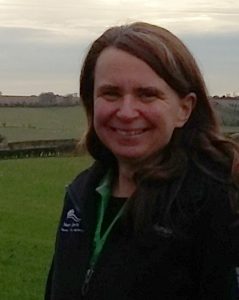Most asked: Elaina Whittaker-Slark, Lead Ranger for the western end of the South Downs National Park
December 4, 2018
 Answers to questions about a particular area of work in the National Park – some sent in to our newsletter and others that we get asked all the time.
Answers to questions about a particular area of work in the National Park – some sent in to our newsletter and others that we get asked all the time.
Answering this month is: Elaina Whittaker-Slark
What does a Lead Ranger do?
I manage a team of two rangers, two assistant rangers and an apprentice ranger and am the main point of contact about ranger work in the western part of the National Park. Our area stretches from the edge of Winchester to just east of Petersfield and reaches to Farnham in the north and Wickham in the south. I also have my own patch, the Meon Valley, to manage – working with the local communities and our volunteers to make a positive difference for biodiversity, access and community. We lead volunteer habitat tasks which at this time of year might mean coppicing, tree planting, hedgelaying and chalk grassland management.
What’s your favourite part of the job?
It’s just so varied. One day I might be planning a five-year project to reintroduce water voles, the next I’m out on the hills managing scrub. This is also the most challenging part of the job – trying to stay on top of all the different tasks, contacts and sites we work with.
Recently one of the Assistant Rangers from my team moved into a Ranger post – I was sad to see her leave but it’s well-deserved and great to see our Assistant Ranger roles working as they should.
A big recent success was working with a local consultant to get a Facilitation Fund for our Winchester Downs farmer group. Our application had a chalk and water theme and detailed how farmers and landowners would work together to enhance this unique landscape.
Any tips for someone who wants to become a ranger?
I’m going to start by assuming that you already have an interest in nature. The next step is to volunteer with as many different organisations as you can and work out which area of being a ranger you enjoy – for example it might be running ecological surveys, leading walks or doing practical work. Then you need to get a theory-based qualification, traditionally at degree level (I studied Environmental Sciences) but there also are apprenticeship schemes available – we have an apprentice, Jane, in our team at the moment.
How’s the new office?
Our team’s just moved to a new office in Droxford in the Meon Valley. You might be surprised to find that a team of rangers are based in a business park but we’re all settled in and it’s nice to be surrounded by diverse local businesses – from a local artist, a printers, vegan catering and a brewery – these are all part of the National Park’s communities.
How are the water voles?
(From 2013-2017 Elaina led a project to reintroduce water voles to the Meon Valley where they were locally extinct)
They’re doing really well, thank you for asking! This year’s surveys revealed thriving populations at all 20 sites where they were released plus evidence they’d reached a further ten locations along the whole of the River Meon.
I was working on a task last week with our volunteers, carrying out maintenance on the river channel and one swum right past us. It’s such a great feeling, and wonderful for the volunteers to see the difference that they’ve made.
How many water voles are there on the river Meon?
I still get asked this all the time and the simple answer is that we don’t know exactly. We couldn’t trap regularly and count them without the risk of causing them trauma, so instead we monitor signs of their presence – for example use of latrine floats and signs of feeding. We released 2,833 in total and we know that they’re breeding well so there’s probably a lot more than that out there now.
